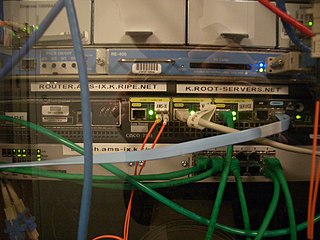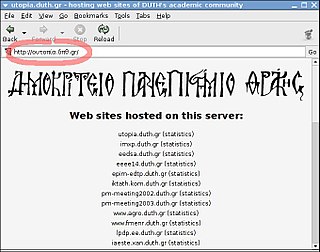The Domain Name System (DNS) is the hierarchical and decentralized naming system used to identify computers reachable through the Internet or other Internet Protocol (IP) networks. The resource records contained in the DNS associate domain names with other forms of information. These are most commonly used to map human-friendly domain names to the numerical IP addresses computers need to locate services and devices using the underlying network protocols, but have been extended over time to perform many other functions as well. The Domain Name System has been an essential component of the functionality of the Internet since 1985.

The Internet Corporation for Assigned Names and Numbers is an American multistakeholder group and nonprofit organization responsible for coordinating the maintenance and procedures of several databases related to the namespaces and numerical spaces of the Internet, ensuring the network's stable and secure operation. ICANN performs the actual technical maintenance work of the Central Internet Address pools and DNS root zone registries pursuant to the Internet Assigned Numbers Authority (IANA) function contract. The contract regarding the IANA stewardship functions between ICANN and the National Telecommunications and Information Administration (NTIA) of the United States Department of Commerce ended on October 1, 2016, formally transitioning the functions to the global multistakeholder community.
A top-level domain (TLD) is one of the domains at the highest level in the hierarchical Domain Name System of the Internet after the root domain. The top-level domain names are installed in the root zone of the name space. For all domains in lower levels, it is the last part of the domain name, that is, the last non empty label of a fully qualified domain name. For example, in the domain name www.example.com, the top-level domain is com. Responsibility for management of most top-level domains is delegated to specific organizations by the ICANN, an Internet multi-stakeholder community, which operates the Internet Assigned Numbers Authority (IANA), and is in charge of maintaining the DNS root zone.
A domain name is a string that identifies a realm of administrative autonomy, authority or control within the Internet. Domain names are used in various networking contexts and for application-specific naming and addressing purposes. In general, a domain name identifies a network domain or an Internet Protocol (IP) resource, such as a personal computer used to access the Internet, or a server computer. Domain names are often used to identify services provided through the Internet, such as websites and email services. As of 2017, 330.6 million domain names had been registered.

A root name server is a name server for the root zone of the Domain Name System (DNS) of the Internet. It directly answers requests for records in the root zone and answers other requests by returning a list of the authoritative name servers for the appropriate top-level domain (TLD). The root name servers are a critical part of the Internet infrastructure because they are the first step in resolving human-readable host names into IP addresses that are used in communication between Internet hosts.
The DNS root zone is the top-level DNS zone in the hierarchical namespace of the Domain Name System (DNS) of the Internet.
Zero-configuration networking (zeroconf) is a set of technologies that automatically creates a usable computer network based on the Internet Protocol Suite (TCP/IP) when computers or network peripherals are interconnected. It does not require manual operator intervention or special configuration servers. Without zeroconf, a network administrator must set up network services, such as Dynamic Host Configuration Protocol (DHCP) and Domain Name System (DNS), or configure each computer's network settings manually.
The Domain Name System Security Extensions (DNSSEC) is a suite of extension specifications by the Internet Engineering Task Force (IETF) for securing data exchanged in the Domain Name System (DNS) in Internet Protocol (IP) networks. The protocol provides cryptographic authentication of data, authenticated denial of existence, and data integrity, but not availability or confidentiality.
The Internet uses the Domain Name System (DNS) to associate numeric computer IP addresses with human-readable names. The top level of the domain name hierarchy, the DNS root, contains the top-level domains that appear as the suffixes of all Internet domain names. The most widely used DNS root is administered by the Internet Corporation for Assigned Names and Numbers (ICANN). In addition, several organizations operate alternative DNS roots, often referred to as alt roots. These alternative domain name systems operate their own root name servers and commonly administer their own specific name spaces consisting of custom top-level domains.

An internationalized domain name (IDN) is an Internet domain name that contains at least one label displayed in software applications, in whole or in part, in non-latin script or alphabet, such as Arabic, Bengali, Chinese, Cyrillic, Devanagari, Greek, Hebrew, Hindi, Tamil or Thai or in the Latin alphabet-based characters with diacritics or ligatures, such as French, German, Italian, Polish, Portuguese or Spanish. These writing systems are encoded by computers in multibyte Unicode. Internationalized domain names are stored in the Domain Name System (DNS) as ASCII strings using Punycode transcription.
In computer networking, a hostname is a label that is assigned to a device connected to a computer network and that is used to identify the device in various forms of electronic communication, such as the World Wide Web. Hostnames may be simple names consisting of a single word or phrase, or they may be structured. Each hostname usually has at least one numeric network address associated with it for routing packets for performance and other reasons.

A fully qualified domain name (FQDN), sometimes also referred to as an absolute domain name, is a domain name that specifies its exact location in the tree hierarchy of the Domain Name System (DNS). It specifies all domain levels, including the top-level domain and the root zone. A fully qualified domain name is distinguished by its lack of ambiguity in terms of DNS zone location in the hierarchy of DNS labels: it can be interpreted only in one way.
The domain name arpa is a top-level domain (TLD) in the Domain Name System (DNS) of the Internet. It is used predominantly for the management of technical network infrastructure. Prominent among such functions are the subdomains in-addr.arpa and ip6.arpa, which provide namespaces for reverse DNS lookup of IPv4 and IPv6 addresses, respectively.
In computer networks, a reverse DNS lookup or reverse DNS resolution (rDNS) is the querying technique of the Domain Name System (DNS) to determine the domain name associated with an IP address – the reverse of the usual "forward" DNS lookup of an IP address from a domain name. The process of reverse resolving of an IP address uses PTR records. rDNS involves searching domain name registry and registrar tables. The reverse DNS database of the Internet is rooted in the .arpa top-level domain.

A DNS zone is a specific portion of the DNS namespace in the Domain Name System (DNS), which is managed by a specific organization or administrator. A DNS zone is an administrative space that allows for more granular control of the DNS components, such as authoritative nameserver. The DNS is broken up into many different zones, which are distinctly managed areas in the DNS namespace. DNS zones are not necessarily physically separated from one another, however, a DNS zone can contain multiple subdomains and multiple zones can exist on the same server.
In the Domain Name System, a LOC record is a means for expressing geographic location information for a domain name.
The name localhost is reserved by the Internet Engineering Task Force (IETF) in RFC 2606 as a domain name label that may not be installed as a top-level domain in the Domain Name System (DNS) of the Internet.
In computer networking, the multicast DNS (mDNS) protocol resolves hostnames to IP addresses within small networks that do not include a local name server. It is a zero-configuration service, using essentially the same programming interfaces, packet formats and operating semantics as unicast Domain Name Service (DNS). It was designed to work as either a stand-alone protocol or compatibly with standard DNS servers. It uses IP multicast User Datagram Protocol (UDP) packets, and is implemented by the Apple Bonjour and open source Avahi software packages, included in most Linux distributions. Although the Windows 10 implementation was limited to discovering networked printers, subsequent releases resolved hostnames as well. mDNS can work in conjunction with DNS Service Discovery (DNS-SD), a companion zero-configuration networking technique specified separately in RFC 6763.
The Domain Name System of the Internet consists of a set of top-level domains that constitute the root domain of the hierarchical name space and database. In the growth of the Internet, it became desirable to expand the initial set of six generic top-level domains in 1984. As a result, new top-level domain names have been proposed for implementation by ICANN. Such proposals included a variety of models ranging from adoption of policies for unrestricted gTLDs that could be registered by anyone for any purpose, to chartered gTLDs for specialized uses by specialized organizations. In October 2000, ICANN published a list of proposals for top-level domain strings it had received.
An internationalized country code top-level domain is a top-level domain in the Domain Name System (DNS) of the Internet. IDN ccTLDs are specially encoded domain names that are displayed in an end user application, such as a web browser, in their language-native script or alphabet, such as the Arabic alphabet, or a non-alphabetic writing system, such as Chinese characters. IDN ccTLDs are an application of the internationalized domain name system to top-level Internet domains assigned to countries, or independent geographic regions.





